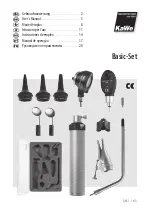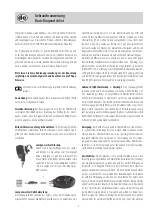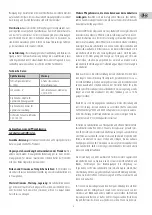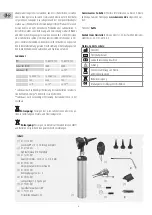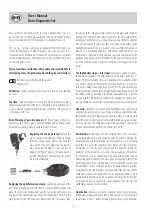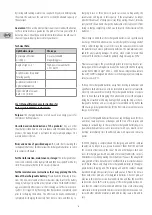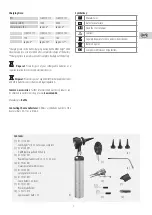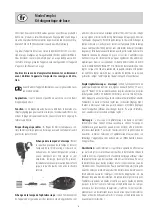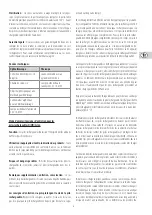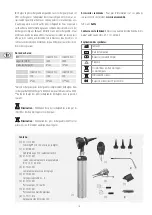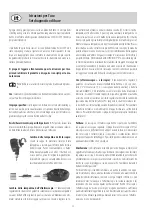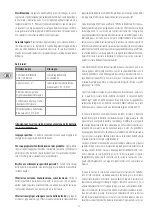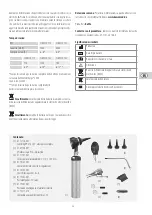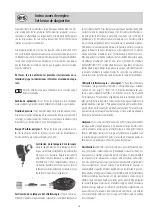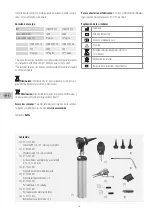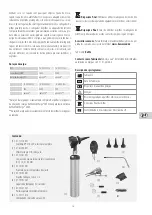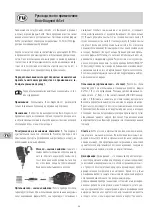
5
User
'
s Manual
Basic Diagnostic Set
Dear Customers! We thank you for choosing a KaWe-product. Our pro-
ducts are known for their high quality and long life. This KaWe product
meets EC Standards 93/42/EWG (Standards for Medical Products).
This is a class 1 product according to Standards 93/42/EWG and is in-
tended for repeated use on different patients. Any other use is not in ac-
cordance with the intended use of the unit. The manufacturer is not liable
for any resultant damages. The manufacturer is also not liable if the unit is
not checked before its use.
Please read these instructions thoroughly and carefully before
attempting to use this product and heed the given instructions.
Familiarise yourself fully with this product
before using it.
Utilization:
The Basic Diagnostic Sets are only to be used by authorized
personnel.
Function:
The Basic Diagnostic Set is to be used for the direct otorhino-
laryngological inspection of the larynx, the auditory canal and the nose. It
is also used used for direct ophthalmoscopic inspection of the eyes and/
or the fundus of the eyes.
Risks/Warning of possible dangers:
1.
Risk of injury of the sensi-
tive mucosa.
2.
After use, please clean the handles with an alcohol-based
disinfectant solution in order to avoid the risk of infection.
Replacing the otoscope lamp:
Remove the
plastic cap from the lamp and remove the lamp
from the otoscope head. If necessary, clean the
glass bulb of the new lamp with alcohol. The
glass bulb must be properly clean and free of
finger prints (free of grease). The lamp must be
pushed carefully into the provided slot until it
touches the lateral pin.
Replacing the ophthalmoscope lamp:
Satisfactory operation of the
unit can only be guaranteed with the use of original KaWe incandescent
lamps that ensure an optimal light quality! Loosen the clamping screw
and remove the ophthalmoscope head from the handle (1). Remove the
lamp holder (2) from the head. Now replace the bulb. If necessary, clean
the glass bulb (3) of the new lamp with alcohol. The glass bulb should be
clean and free of finger prints (grease free). Insert the new lamp with the
lamp holder in the head. Now, rescrew the union ring. The KaWe ophthal-
moscope is designed in such a way that it can also be used without pupil
dilating medication. In this case however, the visual field of the patient is
reduced. The illumination brightness of the KaWe EUROLIGHT® E10 can
be adjusted. A reduction of the brightness causes an enlargement of the
pupil and the patient will be less blinded by the light. Ametropia can be
corrected with the device’s correction wheel by either the patient or the
doctor.
Use (Ophthalm Otoscope):
Satisfactory operation is guar-
anteed when standard 2.5V KaWe handles are used with 2 batteries (”C“
Baby 1.5V. We recommend the use of alkaline batteries) or a KaWe-NiMH
2.5V battery. Slip the instrument head onto the unit and lock it into place.
Turn on the sliding switch by pushing it to the left. The light intensity can
be easily adjusted with the rheostat (maximum switch position). Turn off
the sliding switch by returning it to the right side and back to its starting
position. Replace the battery/accumulator by opening the bottom-lock-
ing cap. Should you need further information, please contact your dealer!
Cleaning:
The KaWe otoscope and the ophthalmoscope can be easily
cleaned with water, alcohol or soap. Please use the otoscope and the oph-
thalmoscope only when they are well cleaned in order to avoid possible
risk of infection. In order to avoid contact with dirt and dust, please always
store the otoscope and ophthalmoscope in their packaging. They can be
cleaned externally with a damp, soft and lint-free cloth.
Desinfection:
Disinfection is the first treatment that is to be carried out
on contaminated objects and materials with the goal of reducing the
microorganisms and further easing the cleaning process. It is extremely
important to prevent the impurities from drying onto the instrument.
Disinfection also has the goal of protecting the personnel during the
treatment of the instruments as well as the surrounding environment.
The instruments can be cleaned and moistened with an alcohol-based
disinfecting agent. Heed the instructions given by the manufacturer of the
disinfecting agent such as reaction time etc. Never allow the otoscope and
the ophthalmoscope to come into contact with liquid and make sure that
no liquid penetrates the housing! Due to the fact that the otoscope and the
ophthalmoscope are not intended for use in surgical procedures, simple
cleaning and/or disinfection with an alcohol-based surface disinfectant
is sufficient. Do not use any abrasive cleansing agents! The otoscope and
ophthalmoscope can not be sterilized!
Sterilization:
Multi-use ear funnel; laryngeal mirror, nasal speculum,
lamp holder (without lamp) and plastic blade holder can be sterilized in
an autoclave at 134°C. Before sterilizing, remove larger-sized impurities
Summary of Contents for Basic-Set
Page 23: ...23...

